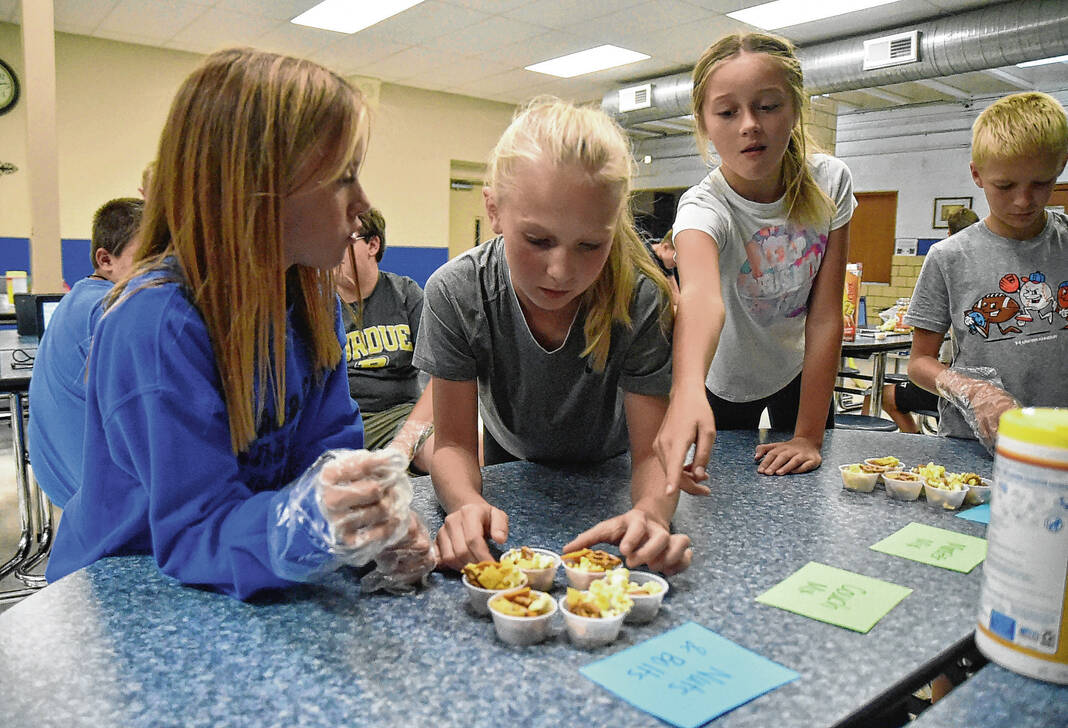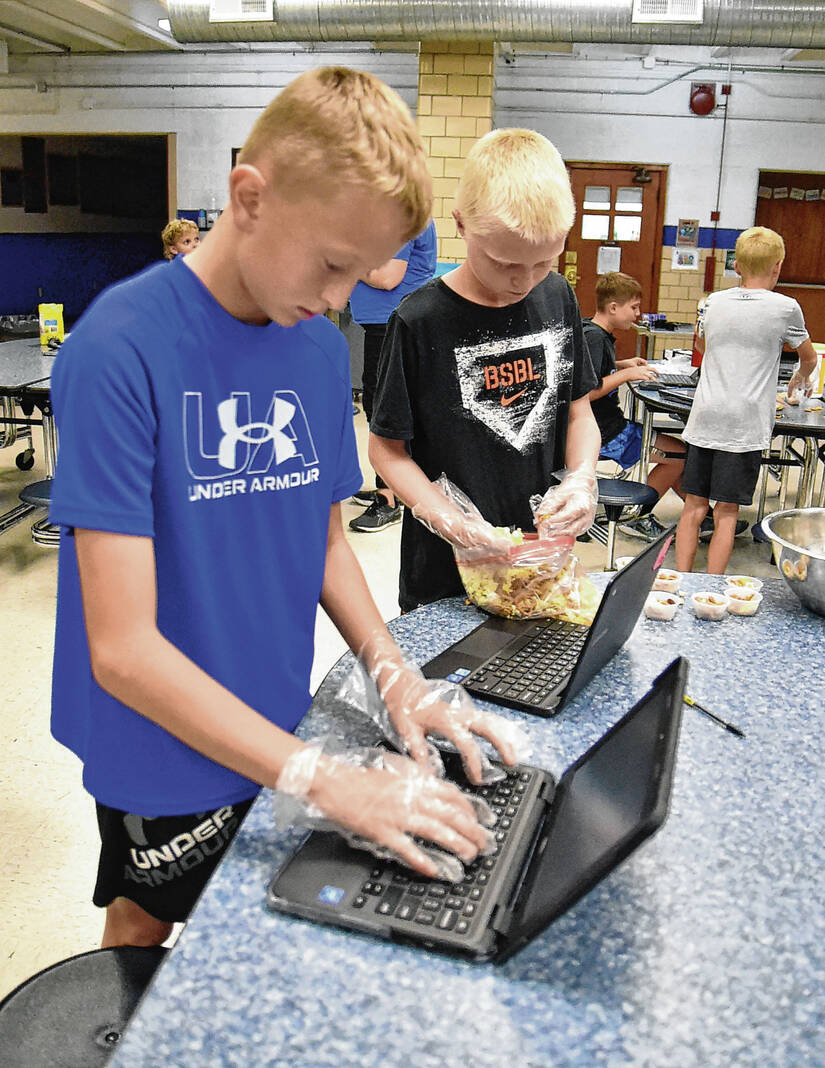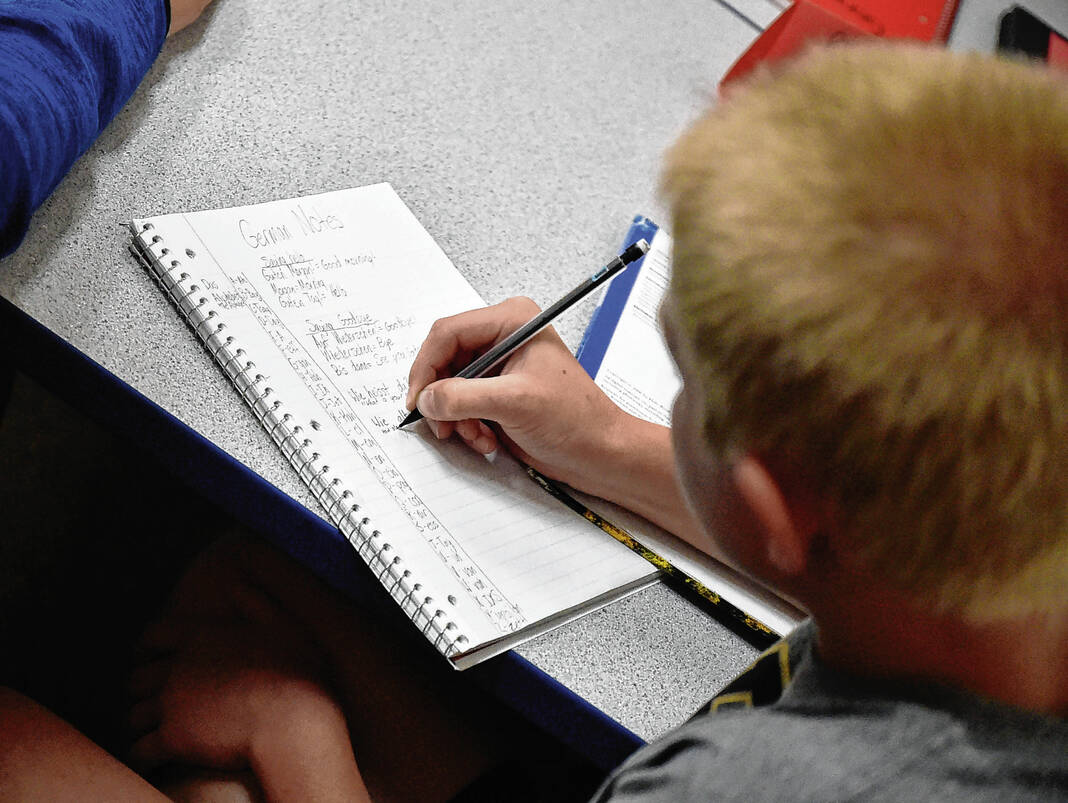
St. John’s Sauers Lutheran School students, from left, Ross Beavers, Luke Schepman, Bode Brooks, Isaac Darlage and Marshall Leinart work on an assignment in the new German class at the school.
Zach Spicer | The Tribune

St. John’s Sauers Lutheran School students Lena Benter, left, and Josie Beavers make their own trail mix during the new nutrition and wellness class.
Zach Spicer | The Tribune

St. John’s Sauers Lutheran School students, from left, Kennedi Butler, Lindsey Klosterman, Addison Sullivan and Parker Broshears put their trail mix creations on a table in the cafeteria during nutrition and wellness class.
Zach Spicer | The Tribune

Teacher Ross Rieckers collects worksheets from seventh- and eighth-graders in the new German class at St. John’s Sauers Lutheran School.
Zach Spicer | The Tribune

Alex Hobson, left, and Cole Brooks work on their trail mix project in the nutrition and wellness class at St. John’s Sauers Lutheran School.
Zach Spicer | The Tribune

Cole Brooks, Trigg Sweany, Branson Ault, Parker Broshears and Noah Lambring do Zumba in the gymnasium at St. John’s Sauers Lutheran School.
Zach Spicer | The Tribune

German is a new class offering at St. John’s Sauers Lutheran School this school year.
Zach Spicer | The Tribune

Cameron Cain, left, and Will Hackman write on note cards in the new German class at St. John’s Sauers Lutheran School.
Zach Spicer | The Tribune

St. John’s Sauers Lutheran School sixth-grader Lena Benter, left, talks to nutrition and wellness teacher Emily Surenkamp as students make their own trail mix recently in class.
Zach Spicer | The Tribune

From left, Lindsey Klosterman, Addison Sullivan and Kennedi Butler do Zumba in the gymnasium at St. John’s Sauers Lutheran School.
Zach Spicer | The Tribune
One of the accreditation requirements for St. John’s Sauers Lutheran School is to offer electives.
Principal Kasee Lambring wanted one to be a foreign language, so last school year, Spanish was offered to students via their Chromebooks.
This school year, one of the school’s teachers, Ross Rieckers, stepped up to teach German.
That’s appropriate since Germans settled in the area in the 1830s, the nearby church is considered the mother church of Lutheranism in Jackson County since it was the first one to be established, the school was erected in 1862 and a lot of Germans are buried in the church’s cemetery.
“I would say this is more meaningful than Spanish on the Chromebook because it actually has some heritage to it,” Rieckers said, as most of the school’s students have German roots.
The other new elective this school year is nutrition and wellness, being taught by head cook Emily Surenkamp.
She started in that role in 2021-22, and then when Lambring suggested adding the elective this year, Surenkamp took it and ran with it.
“I took a class this summer through the Teachers College at Columbia University to learn more about teaching food and nutrition, and one thing evidence-based research points to in getting students to be healthier is to increase physical activity and eat healthier, less-processed foods,” she said. “So how do we get students to want to eat healthier? We get them involved hands-on.”
After spending Tuesdays in the classroom, students have lab Thursdays, where they get to apply what they learn in making various types of food. The wellness part comes in with tracking daily physical activity and also extended time after lab Thursdays for some sort of activity, which for the first eight weeks is Zumba.
“The kids seem to be enjoying it so far. I hope it makes a difference,” Surenkamp said.
For the first semester, seventh- and eighth-graders are taking German, and fifth- and sixth-graders are taking nutrition and wellness. Then for the second semester, they will switch.
While German is new to most of the students, Rieckers said they are excited about it.
“The biggest thing with German that I think will be different for them than English is the fact that the word order is not always the same like in our English sentences: Subject, verb, object,” he said. “In German, the verb can be at the end, and there will be a helping verb at the beginning, so that’s what’s going to trip them up sometimes.”
There are, however, a lot of words between the two languages that are similar, he said.
“German is an older language than English, so you can see the same sort of roots in a lot of the words, even though they may spell it with a K instead of a C or whatever,” he said.
Rieckers has 25 students in his class Tuesdays and Thursdays. Even the school janitor comes in to learn the new language.
“He’s wanting to learn German so he can go over to Germany and try to find some long-lost relatives,” Rieckers said.
Brownstown Central High School is another school in the county that offers German as a foreign language, and Rieckers hopes for some collaboration, including pen pals between the St. John’s and Brownstown students and other activities.
Rieckers said the younger that students learn German, the easier it is, and Surenkamp said it’s the same concept with nutrition and wellness.
“Today’s youth is tomorrow’s future, and healthy eating habits start forming at a very young age,” she said.
There is no formal state requirement for any food and nutrition training and education outside of the limited information in science books until high school, but Surenkamp said according to the Centers for Disease Control and Prevention, 1 in 5 children between the ages of 2 and 19 in the United States is obese.
“One of the best ways to combat this issue, which later in life causes high blood pressure, high cholesterol, Type 2 diabetes, breathing problems and joint problems, is through childhood nutrition education,” she said.
“The government continues to try to respond to this obesity issue by imposing more and more rules and regulations on the National School Lunch Program. In fact, next school year, they are reducing the amount of sodium allowed in school meals yet again,” she said. “With budget cuts and food supply issues, including cost and availability, many schools have turned to a menu full of processed foods; however, processed foods are full of sodium. It’s a catch 22.”
There are a lot of articles and research out there about how students will be more willing to try a new food if they grow it, and they are many times more likely to try and/or eat a healthier food if they have a hand in making it, Surenkamp said.
So in this new class at Sauers, students spend Tuesdays in the classroom learning foundational elements of nutrition. The first week, they started very basic with learning about the five food groups and the U.S. Department of Agriculture food guideline My Plate.
Then the second week, they moved to learning how to keep food safe by applying the four food safety rules: Clean, separate, cook and chill.
Thursdays are lab days, where they go to the cafeteria and kitchen and make something healthy while applying the concepts they learn. They also in turn learn how to use basic kitchen tools and equipment, Surenkamp said.
“I definitely wanted to incorporate the nutrition aspect of it because I know that it’s not getting taught until high school maybe if they choose to take that class,” she said. “Since I could create it, I wanted to make sure they got the opportunity to learn that so they could be equipped with the skills they need to be successful as adults.”
Fifth-grader Parker Broshears and sixth-grader Lena Benter both said they have liked the nutrition and wellness class so far. One week in the lab, they worked with partners to make food creatures with fruits and vegetables, and another week, they made their own trail mix.
“I like that we go down here on Thursdays using the lab. I think it’s a good experience. It teaches (students) how to use things the proper way,” Broshears said.
“I enjoy the hands-on part. I do foods in 4-H, so I feel like it’s going to help me with that,” Benter said. “Then I really like the activity part, and I feel like the part on Tuesdays when we’re in the classroom will help us with our skills.”
For the wellness part, while he may not be a Zumba master yet, Broshears said he likes the time in the gym. Benter likes it, too.
“I really enjoyed the second dance where we got to do the freestyle,” she said after a recent class session.
Next semester, they are looking forward to learning German.
“I have mostly German (heritage), but I have some American Indian, so I’m really excited for that,” she said. “Actually, there’s an app through Lingo I’ve started taking lessons on already. I have been all summer.”
